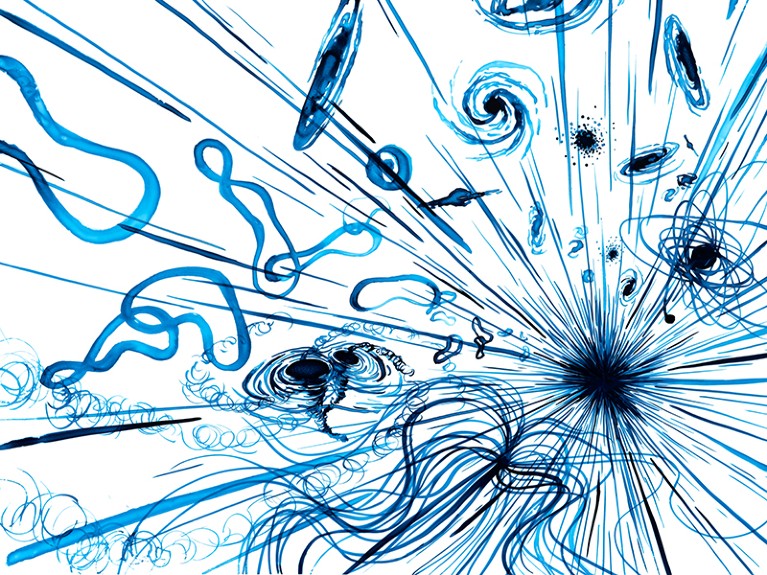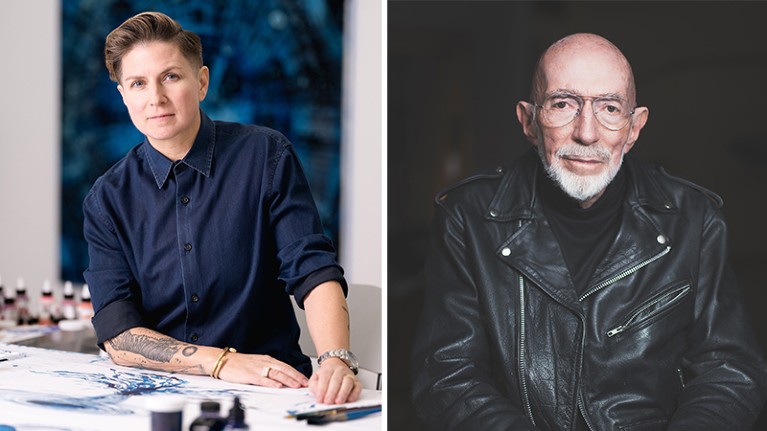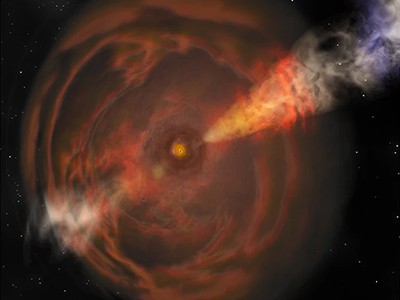

Warped space-time around a black hole, as portrayed by artist Lia Halloran.Credit: Lia Halloran
The Warped Side of Our Universe: An Odyssey through Black Holes, Wormholes, Time Travel, and Gravitational Waves Kip Thorne & Lia Halloran Liveright (2023)
Physicist Kip Thorne and visual artist Lia Halloran began to collaborate on a magazine article about the strange, warped space-time in and around a black hole more than a decade ago. It was never published — but it inspired a much more ambitious project.
The pair have just released an illustrated book portraying space-time storms generated by colliding black holes and neutron stars, as well as wormholes and the possibility of time machines — with explanations and illustrations all guided by cutting-edge computer simulations. It’s an intimate account, too. Halloran’s paintings depict her wife, Felicia, with her body stretching, spinning and contorting as she nears the gravitational maw of a black hole. Thorne expresses his words in verse.

Gravitational waves from giant black-hole collision reveal long-sought ‘ringing’
Thorne, who is professor emeritus at the California Institute of Technology in Pasadena, won a share of the 2017 Nobel Prize in Physics for his contributions to the development of the Laser Interferometer Gravitational-Wave Observatory (LIGO), the facility that made the first direct detection of the ripples in space-time known as gravitational waves. Halloran is chair of the art department at Chapman University in Orange, California. They spoke to Nature about their book, The Warped Side of Our Universe.
You say you’ve learnt a lot from each other. What, for example?
Thorne: Yes, the structures of singularities — locations of infinite density — inside a black hole. Singularities have always been drawn basically as points, but that does not begin to capture what the mathematics tells us. Physical laws say that as you approach a singularity, things get alternately stretched and squeezed in a manner that is truly chaotic. How do you depict that?
Halloran: I painted what Kip was describing about singularities: something that has geometrical shapes and surprises and chaos. But when I finished and looked at the painting, I also understood more clearly what he was saying — and that was a surprise. Singularities have perplexed me as an artist, and fascinated me. Terms such as ‘infinitely dense’ and ‘infinitely massive’ boggle my mind. How we understand the world we’re in drives my studio practice. I have taken physics and astronomy classes. I never wanted to be a scientist, but I loved the way science challenged me.

Lia Halloran (left) and Kip Thorne have been collaborating for more than a decade.Credit: Adam Ottke/Christopher Michel
Kip, why did you write in verse?
Thorne: Verse forces the mind to focus. If I’m writing in prose, there’s lots of detail and the focus is not nearly so intense. The verse sucks out the essence of what’s going on and conveys that in a manner that is almost visceral. And that influences how the reader thinks about it, and how I think about it.
When I was a boy in Logan, Utah, I had a newspaper delivery route and to alleviate boredom I would memorize poetry. What stuck with me most was the poetry of Robert Service — in particular, the ballad ‘The Cremation of Sam McGee’ — the humour in it and the alternating meter. I remembered the poem all these years later, and it’s the meter that I use in the book.
Isn’t that quite a departure for you?
Thorne: Early in my career, I co-wrote the textbook Gravitation (1973) with Charles Misner and John Wheeler. That was a landmark in terms of introducing new elements into a scientific textbook, filled with boxes, marginal comments, different fonts and a long list of other tools. I took great pride in introducing a new style of communicating science.

Mysterious ‘Tasmanian devil’ space explosion baffles astronomers
I feel that in my collaboration with Lia, I’ve accomplished that for the second time: a book that is a new way of communicating science to non-scientists. The integrated painting and the verse — it’s a very different style in a very different vehicle that conveys a very different aspect of science than anything that I’ve ever done before or that I’ve seen before.
Kip, you’ve said that when someone falls into a black hole, their head will twist one way and their feet the other. How do you know?
Thorne: It’s obvious in the mathematics, but computer simulations rub your nose in things that you had not noticed. They capture the twisting much better. We could not have seen this in the simulations of 15 years ago; that was far beyond our capabilities.
And, Lia, why depict your wife in peril near a black hole?
Halloran: We were not focused on the peril, more on the adventure of getting close to a black hole. As well as Felicia, the book depicts people who have been integral to Kip’s career. When have you seen a book that’s about a black hole and gravity that subtly talks about intimacy, about love, about friendship? We believe deeply that if the viewer can feel a personal connection, they are going to be even more curious and engaged in the material.
Thorne: Also, we found that as well as the violent singularity, there are also two gentle singularities inside the hole, which Felicia could survive. We don’t describe it, but Felicia might make it through those two singularities intact.
Kip, it took a team of 1,000 to build LIGO and you’ve told the Nobel Prize Committee that it should have given the prize to the team and not three people. Should the awards change to allow more recipients?
Thorne: I don’t see how the committee can avoid it much longer. It’s basically turning its backs on the nature of big science. That’s not by any means all science, but in physics and in chemistry and in biology, some pieces of science can be done only by large collaborations. And the power of large collaborations is something that the general public needs to understand and appreciate.
What are the next challenges for understanding gravity?
Thorne: Well, I think developing a theory of quantum gravity is the holy grail in theoretical physics at this time, because it controls the birth of the Universe and lots of other things — such as whether or not time machines would self-destruct when you try to turn them on, and what goes on inside a black hole.
Beyond that, there’s also the issue of how warped space-time behaves in the real Universe, and what kinds of phenomenon it produces — such as space-time storms when black holes collide and stretching and squeezing and twisting as you approach a chaotic singularity. With the discovery of gravitational waves, we have made our first contact with the warped side of the Universe, and there’s much more to learn about it.
And what do you think will happen in gravitational-wave research over the next decade?
Thorne: This year, the European Pulsar Timing Array and other observatories reported detecting a background of gravitational waves from colliding supermassive black holes, and perhaps from the birth of the Universe. Future discoveries, with LIGO and its successors on the ground as well as gravitational observatories in space, will deepen our understanding of warped space-time. Today, we’re in the same situation we were in four centuries ago, when Galileo built the first optical telescope. He and other astronomers discovered a new world—the richness of the Solar System. Now, we’re poised to discover the richness of the cosmos.

